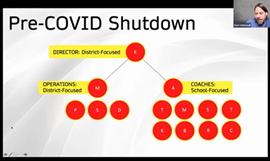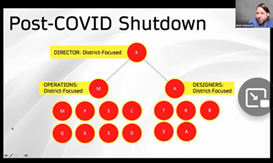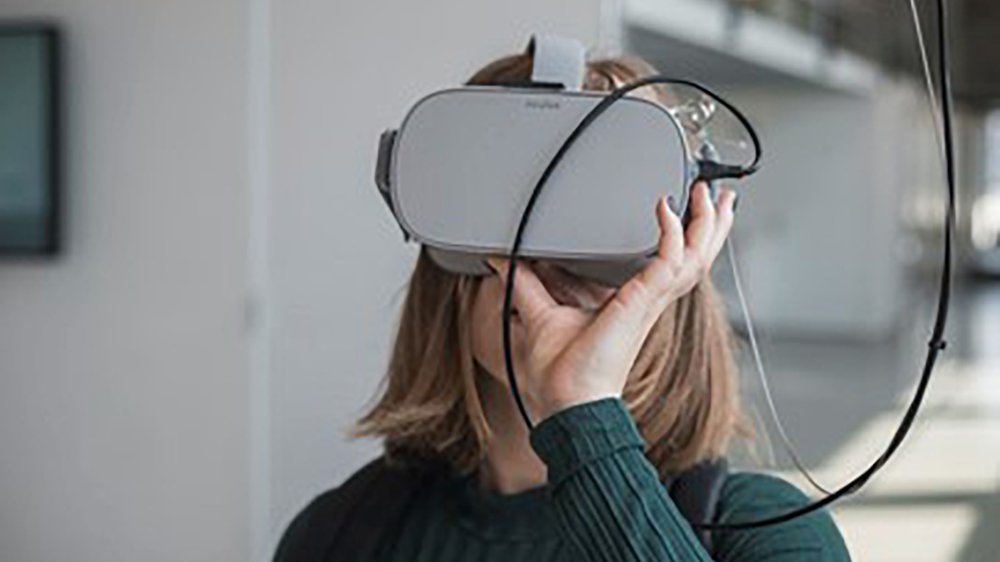A recent Learning Counsel event for the State of Tennessee highlighted a trend in shifting instructional tech staff operations in schools and districts. Williamson County Schools, with 41,500 students and 51 schools has, like many districts, morphed to a different structure in response to changed demands. At the Nashville Digital Transition Discussion event in October 2021, Matt Hollowell, Curriculum Specialist – Instructional Technology at Williamson County Schools presented on how much the focus of staff work has changed to provide more precision help that teachers, students and parents need now.
“We are rebuilding our structure, but it's also rebuilding our trust. My department has had to rebuild trust constantly. I mean, literally in the past two days, I'm re-scoping and rebuilding an application and people have lost their access and they don't know what's going on and we have to fix it. There’s a lot of trust that we must rebuild with parents, especially in this district, but with our staff, with our teachers, with our students, with our central office, with our curriculum specialists. And that's kind of led to this whole idea in my department of restructuring. I'm going to show you what that looks like on paper. It's actually fun to do this presentation because I had not actually seen it in this sort of format before I started putting it together,” said Hollowell during the session
“I do want to pause for just a second before I go to the next slide and say this about LeiLani Cauthen (CEO of Learning Counsel). Four years ago, I think, is when we first attended the Learning Counsel (meeting). And I sat, I think it was at Vanderbilt, and listened to LeiLani talk about these new job titles that were like digital designer and digital curator. And I was like, ‘I don't know what she's talking about.’ Like we have tech coaches, and we have, you know, we have our people over here. Then, fast forward, four years. And we have now digital designers and an actual digital curator in our department. I think Allison (Fisher, Principal WCS Online High School) has one as well. I want to give points to LeiLani for showing me the way four years ago of what we would look like in the future. I appreciate it.
“In the beginning, we had a very school-focused group of tech coaches. They would be called out to schools for some issue or how to integrate tech. Fast-forward to the beginning of this school year (2021), and we have very much shifted resources to the operations side. Those tech coaches turned into digital designers this year. Instead of individual teacher and individual school (attention), we have to be able to deliver things district-wide. In the operations side, we have a new hierarchy where we have a frontline of tier one people which answer a lot of our help tickets. Then we have our tier two people, which do a lot of work in our SIS, managing all sorts of forms and imports and exports of data. We have an apps manager. So again, back two years ago, there were just a couple of us, and now we have an entire structure, which has been very much necessary because of the change in our tech climate and population. The other thing that we've changed is how we do help support. We were an email driven environment, which we knew was not sustainable. Fast forward and you can see now that we have completely changed our structure. We now have a parent help desk. We have a teacher help desk and we have a student help desk, which again, we never had in the past.


“Looking at the patterns and data analysis has been really important to us. When everything was an email, you can't find a pattern anywhere, it's just drowning in email all the time. We now can look and say, ‘Hey, look at this help desk, we have 12 tickets on the same issue.’ That kind of pattern recognition has really been important to us because we can stop the flow of email and help tickets by fixing the actual problem.
“We’re working on being able to put out much more robust and much more interesting data, which is not something we would have done pre-COVID. It just wasn't on our list to focus on. But I think that we're going to be able to provide all sorts of learning and data for our students, to our teachers going forward.
“We spent the better part of the year just shifting (software) licenses around and trying to explain to our tech partners, ‘You have got to be more flexible. This is not going to work, the rigidity of what you worked with before (for school structure, grades and classes).’ I think, LeiLani, that speaks to your conversation of the friction of the old model. I mean, the friction is my best word for it, which is even in our SIS (Student Information System) and Allison can speak to this because she is our scheduler. I'm trying to schedule these online classes into SIS, which doesn't allow you to schedule classes a certain way, and has taken an awful lot of creativity and data manipulation to get done.”
During the event the Learning Counsel then led the conversation to school models based on a recent Special Report entitled Learning Leadership versus Systemic Inequities.
“Being able to really personalize and knowing our teachers the way I know them; this is what they want as well, (the newest Hybrid Logistics model), said Hollowell. “They want to teach, they don't want to just put the kids on all the technology. They don't want to not know what the kids are doing. They want to know where the knowledge gaps are. Not just because the reports spit it out for them. But we have, as everyone has, been overworked, overstressed, completely checked out. So, I love the model and I hope we go towards this. I just know it's breaking the mold. It really is. And thankfully we've done nothing but break the mold. In the past two years, we've had to break every single rule that we have to get these kids educated.”
The video of Hollowell and Fisher’s discussion is a separate story on the Learning Counsel site.
About the author

LeiLani Cauthen is the CEO and Publisher of The Learning Counsel. She is well versed in the digital content universe, software development, the adoption process, school coverage models, and helping define this century’s real change to teaching and learning. She is an author and media personality with twenty years of research, news media publishing and market leadership in the high tech, education and government industries.











